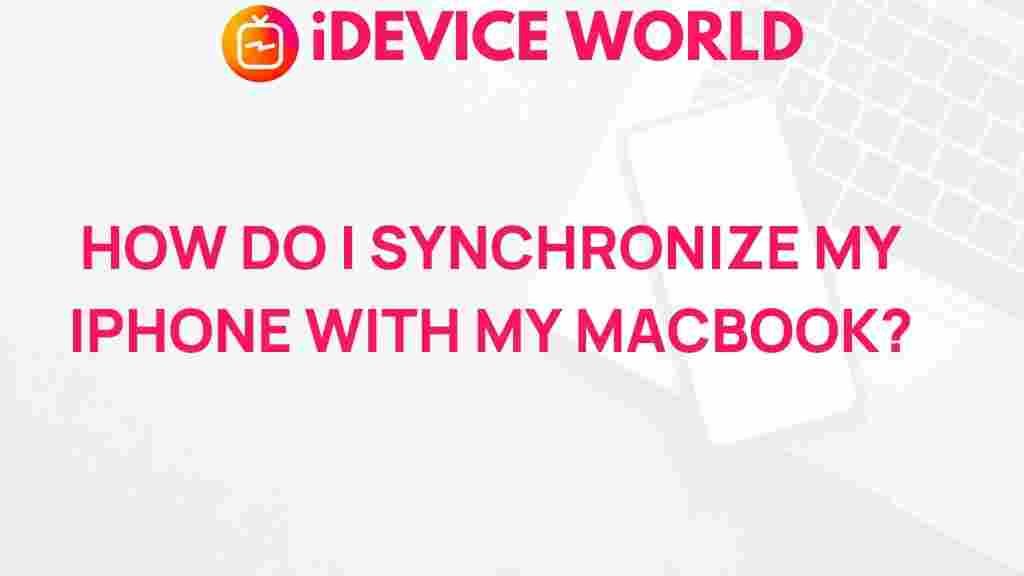Mastering iPhone Syncing with Your MacBook: A Complete Guide
Syncing your iPhone with your MacBook is one of the easiest ways to ensure that your photos, music, documents, and other vital data are always up to date. With seamless integration between Apple devices, syncing your iPhone can improve your productivity, keep your information secure, and make sharing data between devices effortless. In this guide, we will dive into all aspects of syncing your iPhone with your MacBook, explore troubleshooting techniques, and provide solutions to common issues. Let’s get started!
Why Syncing Your iPhone with Your MacBook is Essential
Syncing your iPhone with your MacBook offers numerous benefits, especially for Apple ecosystem users. By syncing your devices, you can:
- Keep photos, contacts, and calendar events in sync
- Backup important files to your MacBook for added security
- Access music, videos, and documents seamlessly on both devices
- Enjoy a smooth experience with productivity apps and iCloud
Whether you’re using iCloud, Finder, or iTunes, syncing your iPhone with your MacBook ensures that all your essential data is securely backed up and accessible on both devices. Here’s how to get started.
Using iCloud for Effortless Syncing
iCloud is Apple’s preferred method of keeping data synchronized across devices. With a few settings adjustments, iCloud can manage the syncing of photos, documents, and other data automatically.
Steps to Sync iPhone with MacBook Using iCloud
- On your iPhone, open Settings, then tap your name at the top to access iCloud settings.
- Select the types of data you wish to sync, such as Photos, Contacts, Calendars, and Reminders.
- Repeat the same process on your MacBook by going to System Preferences > Apple ID > iCloud.
- Enable the relevant data types to ensure they stay in sync between your iPhone and MacBook.
Using iCloud not only syncs your information but also allows you to access it from other Apple devices, including iPad and Apple Watch. For more details on iCloud, visit the official Apple iCloud support page.
Syncing with Finder or iTunes
If you prefer to keep data stored locally on your MacBook rather than in the cloud, you can use Finder (macOS Catalina and later) or iTunes (macOS Mojave and earlier) to sync your iPhone.
Steps to Sync iPhone with MacBook Using Finder or iTunes
- Connect your iPhone to your MacBook using a USB cable.
- On macOS Catalina and later, open Finder. For macOS Mojave and earlier, open iTunes.
- Select your iPhone under the “Locations” section in Finder or the device icon in iTunes.
- Choose the types of content you want to sync, such as Music, Photos, Contacts, or Apps.
- Click Apply to start the sync process.
Using Finder or iTunes can provide greater control over your iPhone’s data and is a reliable option if you have limited iCloud storage. For more guidance on Finder, check out our step-by-step guide.
Syncing Specific Content from iPhone to MacBook
1. Syncing Photos
Syncing photos between your iPhone and MacBook can be done via iCloud Photos or manually using Finder or iTunes. iCloud Photos automatically syncs images as you take them, whereas Finder and iTunes allow for selective photo syncing.
2. Syncing Music and Media
Using Apple Music or syncing with Finder/iTunes is the best way to keep your music library up to date. Apple Music subscribers can enable Sync Library in Settings to have access to music across devices.
3. Syncing Contacts and Calendars
Contacts and calendars are easily synchronized using iCloud. Simply enable Contacts and Calendars in your iCloud settings on both devices to keep them aligned.
Troubleshooting Common Syncing Issues
Despite the seamless nature of Apple’s ecosystem, syncing issues can sometimes arise. Here are common problems and solutions:
1. iPhone Not Showing Up in Finder or iTunes
If your iPhone isn’t appearing in Finder or iTunes, try the following steps:
- Check the USB connection and use a different cable if needed.
- Ensure both devices are running the latest versions of macOS and iOS.
- Restart both your iPhone and MacBook.
- If the issue persists, try reinstalling iTunes (for macOS Mojave and earlier).
2. iCloud Syncing Delays
Occasionally, iCloud syncing may experience delays. To resolve this:
- Ensure that iCloud Backup is enabled on your iPhone.
- Connect to a stable Wi-Fi network.
- Check your iCloud storage limits.
- Try logging out and logging back into your iCloud account.
3. Unable to Sync Music or Photos
If you face issues syncing music or photos, consider the following:
- Verify that Apple Music or iCloud Photos are enabled on both devices.
- Disable and then re-enable Sync Library or iCloud Photos if necessary.
- Use Finder or iTunes to sync manually if automatic syncing isn’t working.
Advanced Syncing Options
For users seeking greater control over their data, advanced syncing options include using third-party apps for selective syncing and organizing your data. Apps like AnyTrans and iMazing can provide additional flexibility, especially if you work across multiple platforms.
Conclusion
Syncing your iPhone with your MacBook offers numerous benefits, from streamlined access to data across devices to improved data security through regular backups. Whether you prefer iCloud’s convenience, the control of Finder or iTunes, or third-party apps for advanced needs, syncing your iPhone can be customized to fit your lifestyle.
By following these guidelines and troubleshooting common issues, you can keep your iPhone and MacBook in perfect sync. This integration allows you to make the most of Apple’s ecosystem, enhancing productivity and ensuring that your data is accessible whenever you need it. Try out these syncing methods today, and enjoy a more connected experience with your Apple devices!
This article is in the category Guides & Tutorials and created by iDeciveWorld Team
